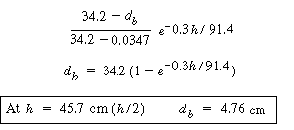Chapter 15: Diffusion and Reaction in Porous Catalysts
Professional Reference Shelf
Example CD12-3: Maximum Solids Holdup
A pilot fluidized bed is to be used to test a chemical reaction. The
bed diameter is 91.4 cm. You wish to process 28.3 x 10 3
cm 3 /s of gaseous
material. The average particle diameter is 100  m. The
reactor height is 10 ft. Allowing for a disengaging height of 7 ft, this means that
we have a maximum bed height of 91.4 cm. The distributor plate is a porous disk. m. The
reactor height is 10 ft. Allowing for a disengaging height of 7 ft, this means that
we have a maximum bed height of 91.4 cm. The distributor plate is a porous disk.What is the maximum weight of solids (i.e., holdup) in the bed? Other data: |
|||
|
Color of pellet: brown
|
|||
| Solution: | |||
|
The amount of solids in the reactor is given by
|
(CD12-19) |
||
The two parameters that need to be found are and and . .
|
|||
A. Calculation of
|
|||
|
|
(CD12-29) | ||
| 1. Gravity term: | |||
|
|
|||
| 2. Cross-sectional area: | |||
|
|
|||
| Superficial velocity: | |||
|
|
|||
| Porosity at minimum fluidization [Equation (CD12-9)]: | |||
|
|
|||
| B. Calculation of volume fraction of bubbles | |||
|
|
(CD12-46) | ||
| Here we see that we must calculate u mf and u b . | |||
| Step 1. First the minimum fluidization velocity is obtained from Equation (CD12-25): | |||
|
|
(CD12-35) | ||
| Step 2. To calculate u b
we must know the size of the bubble d b
, that is, (CD12-36): |
|||
|
|
(CD12-36) | ||
| Step 3. The average size of the bubble, db , is determined by evaluating Equation (CD12-37) at h/2: | |||
|
|
(CD12-37) | ||
| where d bm and d b0 are given in Equations (CD12-38) and (CD12-39), respectively | |||
| Maximum bubble diameter: | |||
|
|
(CD12-38) | ||
| Minimum bubble diameter: | |||
|
|
(CD12-39) | ||
| Solving for d b yields | |||
|
|
|||
| At the top of the bed (h = 91.4 cm), d b = 8.86 cm. For purposes of the Kunii-Levenspiel model, we shall take the bubble diameter to be 5 cm | |||
| Step 4. We can now return to calculate the velocity of bubble rise and the fraction of bed occupied by bubbles from Equation (CD12-36). We have | |||
|
|
|||
From Figure CD12-6 we see that a 100- m particle corresponds
to a value of m particle corresponds
to a value of of 0.5. Substituting this value into Equation (CD12-46),
the fraction of the bed occupied by the bubble is of 0.5. Substituting this value into Equation (CD12-46),
the fraction of the bed occupied by the bubble is
|
|||
|
|
|||
| Thus 94% of the bed is in the emulsion phase plus the wakes. | |||
| C. Amount of solids holdup, | |||

|
|||
| or | |||
| W s = 678 lb of solid particles | |||















